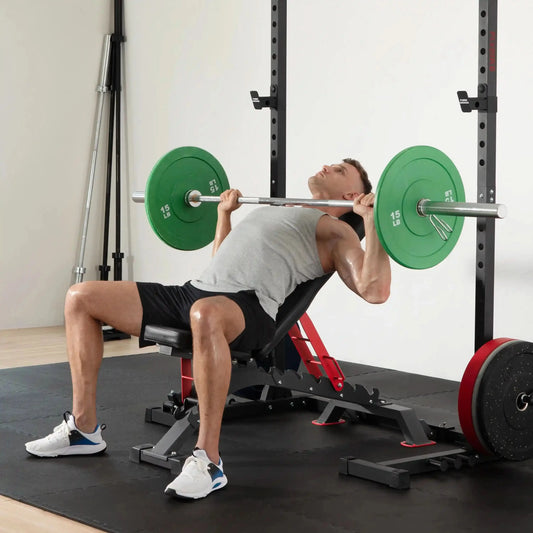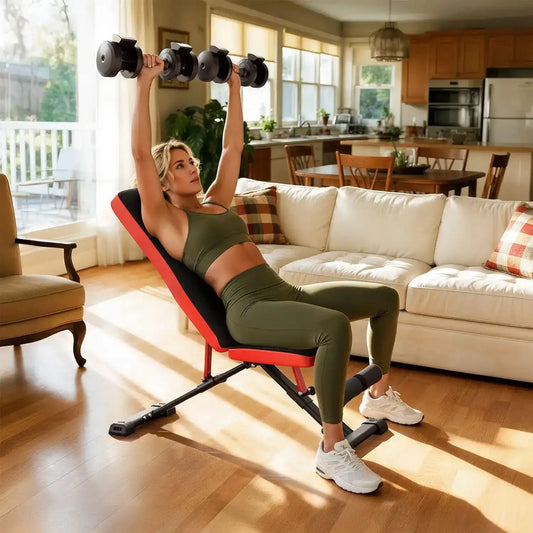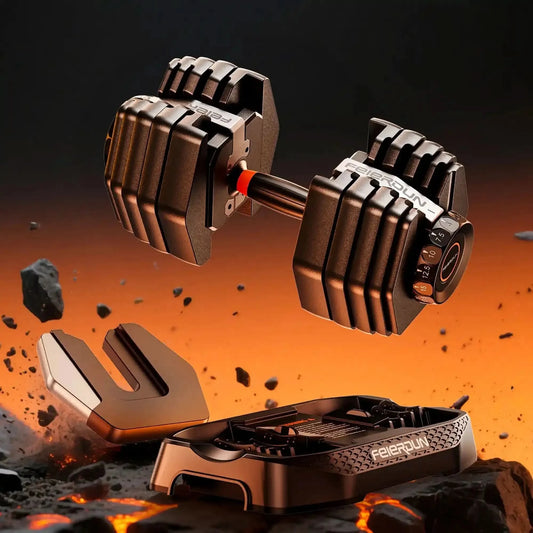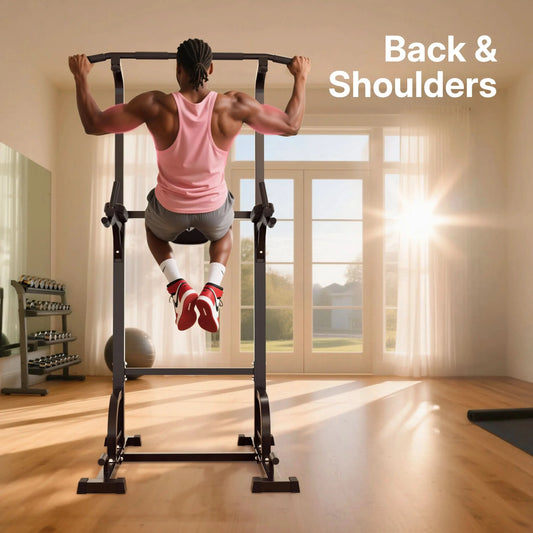Many people ask, "Shou ld I do the incline bench press or the flat bench press?" In this article, I'll analyze the key differences between the flat and incline bench presses based on biomechanics, EMG research, and performance results. Ultimately, you'll understand which bench press is right for you and why.
As a fitness professional, I have been asked this question hundreds of times: ‘Should I focus on the flat bench press or the inclined bench press to build the perfect chest?' I believe this question is valid and requires much more than casual gym floor advice.
The decision isn’t as black and white as “keep one and ignore the other”. You need to understand how these two bench presses work and how they target different areas of the chest muscles. You also need to understand how to choose and set up your bench press equipment and master the precise timing of each exercise to enhance your overall training strategy.
So let’s get started
What is a flat bench press, and how to do it right?
It's a benchmark for upper body press strength, ideal for boosting intensity and volume. This strength training exercise, performed by lying flat on a bench and pressing a weight upward, primarily targets the middle portion of the pectoralis major, with the anterior deltoids and triceps also participating. Along with the squat and deadlift, it forms part of powerlifting. However, in powerlifting competitions, only barbells are used, but today I will introduce dumbbells and barbells that we will use in our daily workouts.
In my experience, this exercise is often misunderstood, not because it is complex, but because most think it's “too easy”. Many people rush into it without proper technique, leaving with little or no gains and even shoulder injuries.
Here is how it should go:
Flat Barbell Bench Press Setup & Execution
Adjust the Equipment
- Place the flat bench in the center of the rack.
- When lying down, the barbell should be directly above your eyes.
- Retract your shoulder blades and keep your arms extended, with the bar slightly lower than your wrists.
Key Points to Remember
- Scapular Retraction
- Tighten and lower your shoulder blades to lock them against the bench.
- Body Stability
- Slightly tuck your feet back, with your toes at a 45-degree angle to the bench.
- Drive your feet firmly into the ground, tighten your quads, squeeze your glutes, and brace your core.
- Keep your back and glutes pressed against the bench.
- Grip Width
- Grip the bar so that when lowered, your upper arms are parallel to the floor and your forearms remain vertical. This is your ideal hand placement.
- Grip Style
- Place the bar across the mid-palm.
- Slightly rotate your hands inward, wrap your thumbs around the bar, and close your fingers tightly for a secure hold.
- Removing the Barbell
- Keep your forearms directly under the bar to reduce elbow stress.
- Once unracked, position the barbell directly above your shoulders.
- Be careful not to let your elbows be parallel to your shoulders, and the line connecting your elbows should almost pass through the middle of your chest.
- The Movement
- Inhale as you lower the barbell slowly to chest level, around the line of your nipples.
- Exhale as you press the bar back up, actively driving your elbows toward the midline for greater chest activation.
- Keep your forearms vertical throughout, allowing the bar to follow a natural arc-like path.
If you plan to do a flat dumbbell bench press
Setup
- Place the dumbbells at your sides.
- Bend your knees, brace your core, keep your back straight, and squat down to pick up the dumbbells.
Execution
- Sit on the bench and position the dumbbells vertically on top of your thighs, holding them near the mid-upper grip area.
- As you lean back, drive your knees upward to help guide the dumbbells into position above your chest with arms extended.
- Plant your toes firmly on the ground (or tuck them slightly inward). Squeeze your glutes against the bench, retract and depress your shoulder blades, and keep your back pressed firmly into the pad.
- Slightly tuck your elbows inward so your forearms remain vertical. Keep your chest lifted and chin tucked.
- Exhale as you press the dumbbells upward. Inhale as you lower them under control until your upper arms are parallel to the floor, maintaining forearms perpendicular to the ground.
- Keep constant tension on your chest. The dumbbells should travel in a slight arc toward the centerline of your body, but do not let them touch at the top.
Finish
- Rotate the dumbbell heads forward, engage your core, and use your legs to assist as you sit back up.
- Rest the dumbbell heads on your thighs, then stand and safely return them to the floor.
Do not get carried away with the adrenaline rush; never bounce the bar off your chest. This may sound cool, but trust me, it can put you off for weeks. Maintain control through every inch of movement.
Which muscles do I primarily work on with the flat bench press?
The flat bench press primarily targets the middle pectoralis major. I'll explain the movement based on the movement path. When pressing the barbell, the pectoralis major is compressed, with the middle pectoralis major receiving the most significant force. This also stretches the triceps and anterior deltoids. As the barbell descends parallel with the nipple line, the pectoralis major feels the stretch, again with the middle pectoralis major being the most noticeable, while the anterior deltoids and biceps also participate. Proper movement execution coordinates these muscle groups, promoting hypertrophy and strength gains in the target muscles.
Key points of exercise
- If the form is incorrect, with the forearms not perpendicular to the ground and adducted, the biceps are primarily targeted.
- If the forearms are extended too far, the triceps are primarily targeted.
- If the elbows are lowered below the shoulder joint, the target muscle shifts from the pectoralis major to the shoulder.
What is an incline bench press, and how to do it properly?
The incline bench press is similar to the flat bench press, differing in the bench angle and the muscles primarily targeted. Using a 30-45 degree incline bench with dumbbells or a barbell, you'll primarily target the upper chest while also engaging the deltoids and triceps.
Here is how I do incline presses:
Set the bench angle
I typically start by adjusting the bench angle to a maximum of 30-45 degrees. However, I prefer 30 degrees because EMG studies have shown that upper pectoral activation is greatest at a 30-degree bench angle. While some people opt for steeper incline angles (over 60 degrees), this shifts the impact force almost entirely to the shoulders. If you're primarily targeting the shoulders, you can increase the bench angle to 45 or even 60 degrees.
Set up the bar or dumbbells
You can either use a bar or/dumbbells here. I like to do both on alternate sets, as it gives better flexibility. The setup is the same as for the flat bench press.
- If using a barbell, place the bench press in the lower center of the barbell rack. Lie down with the barbell directly above your eyes, and your wrists slightly lower than the barbell when you extend your arms.
- If using dumbbells, place them at your sides, bend your knees, and brace your core to squat down to pick up the dumbbells.
Bracing and foot position
Like a flat bench press, tilt your toes outward 45 degrees, and place your feet firmly on the ground. At the same time, tighten your shoulder blades and keep your hips and upper back tightly against the bench.
Controlled descent
The next step is to slowly lower the barbell to the top of my chest, just below my collarbone. If I use dumbbells during the incline bench press, my elbows maintain a 45-70 degree angle to my body. You can use this angle to determine if you are performing the exercise correctly.
Drive and lockout
Now, I will push the barbell or dumbbells upwards, just like the flat bench press. If it is a barbell, hold the barbell with your forearms perpendicular to the ground and push it up. If it is dumbbells, when your upper arms are parallel to the ground, push the dumbbells vertically upwards, and apply force to the inside of your chest. The dumbbells do not need to touch each other. The trajectory should be close to the center of the body. Keep the upper chest and triceps tight.
What muscles does the incline bench press primarily target?
The incline bench press primarily targets the upper portion of the pectoralis major. As you push the weight upward, you'll feel noticeable pressure on the upper portion of the pectoralis major. As the weight descends below the sternoclavicular bone, you'll feel a noticeable pull on the upper portion of the pectoralis major. Throughout this process, your anterior deltoids, triceps, and biceps are also engaged.
Flat bench vs Incline bench: Key differences
If both of these presses target the chest, how are they different?
The main difference lies in the muscles they target. Performance and EMG results show that the flat bench press targets the thick central chest area, which increases size and strength. It also helps build muscle volume. For clients seeking overall muscle growth, I almost always choose the flat bench press. The incline bench press, on the other hand, changes the angle of the bench press, which almost completely alters the muscle groups targeted. A 30-degree angle maximizes stimulation of the upper pectoral muscles, while increasing the angle gradually reduces stimulation of the deltoids. At 45 degrees, stimulation shifts almost entirely from the upper chest to the shoulders. Therefore, neglecting the angle will not only prevent a well-defined chest but also lead to an imbalanced posture.
Unless you're recovering from a shoulder injury, both are essential exercises. The flat bench press builds muscle, while the incline press achieves more balanced growth.
What do they have in common?
Although the target muscles are slightly different, the flat and incline press serve one common purpose: to build compound pushing movements. They target the pectoralis major from different angles, which is the fan shaped muscle that makes up the bulk of the chest.
Apart from the pectoralis major, both these exercises activate the front shoulder and triceps, building a functional upper body pushing strength.
What are the advantages and disadvantages of each?
Flat bench press
Pros:
- Maximum activation of the central chest.
- Allows greeter lifts due to a stronger mechanical position.
- Engages front shoulder and triceps to improve overall upper body pushing strength
- Adds more volume and bulk to the central chest area.
Cons:
- Increased strain on the shoulder joint if the bar is lowered too far.
- Does not engage the upper chest as much, resulting in an unbalanced
Incline bench press
Pros:
- Greater upper chest activation
- Makes a well-developed, fuller chest with good aesthetic balance
Cons:
- Does not support heavier loads; normally, you will need 10-30% less load compared to the flat bench press
- Focus is shifted off the chest when the incline angle is too steep (>45)
- Not suitable for athletes in injury rehab, as it puts more strain on the shoulder joint
What should you choose?
There is no one right answer to this. What I have learnt from training 100s of clients is that the choice depends on some factors like:
- Your training requirements
- If you are recovering from an injury
- Equipment availability
Let me break these down for you.
Training requirement
If your goal is to build overall chest mass, there is no better exercise in the world than the flat press. It activates the entire chest muscles, especially the lower and central regions.
However, if your upper chest is not developed as it should be, and your body is in kind of an imbalance, then go for the incline chest press.
Another important thing is your experience. For most beginners, the flat bench press is more suited as it offers better posture, and you can lift substantial weights from this position. Once you are satisfied with your lower chest growth, you can switch to the incline press for a balanced physique.
Injury rehab
If you are recovering from a shoulder injury like labral tears, rotator cuff strain, or any other shoulder-related issues, you will need to be careful. I personally recommended avoiding the incline press for at least a month if you are recovering from a shoulder injury, as it increases shoulder flexion and anterior deltoid involvement.
In my rehab routine, I prefer to do flat dumbbell presses because they offer natural joint movement and better control.
Equipment availability
Not all of us have access to a fully equipped gym all the time. So, if your gym only has a flat bench press, you can still do pretty well with this. And, if you are buying a weight bench for your home gym, I would recommend buying an adjustable weight bench, you can browse our
adjustable bench.
This is a great investment as it offers you more control over your exercise routine. Just check the weight (your weight + the weight you are lifting) capacity of the bench before you get going.
What I’ve learned after years of training
After working for more than 10 years in the fitness industry and training clients from beginners to professional athletes, there is one thing I appreciate more than anything: while both flat and incline presses are important to develop your chest, they both target uniquely different parts of the pectoral musculature.
One mistake that I have seen too many athletes make is overemphasizing the flat bench press, assuming it is only enough to develop a fuller, balanced chest. Due to this very reason, upper chest imbalance is one of the most common problems in beginners and intermediates.
Here is what I teach my clients:
- Do not overdo the flat bench press
- Stay away from the incline press when in injury rehab
- Do not ever think you can lift the same weight on an incline that you lift in your flat bench press
- Always warm up your shoulders before pressing
- Be careful not to let your elbows lie parallel to your shoulders; otherwise, the center of gravity will shift to your shoulders.
- Keep your forearms vertical. If your forearms are pulled inward, you'll primarily work your biceps. If your forearms are extended too far outward, you'll primarily work your triceps.
- Keep your shoulder blades tight throughout the entire movement, and keep your buttocks and back pressed against the bench.
- Avoid shrugging your shoulders: If you shrug your shoulders while bench pressing, you completely lose the opportunity to work your pectoralis major muscles.
It's all about achieving the right balance between both incline and flat bench press.
Which One Wins? Your Chest Needs Both
So, if you ask me which one is better? I would probably say the best chest development does not come from choosing one side, but from including both these in your exercise routine.
The flat bench lays the foundation, building size and pressing strength, and incline press shapes the upper chest, ensuring balanced growth. In most of my training programs, I choose a hybrid approach and alternate both them, depending on the training goals and injury history.












